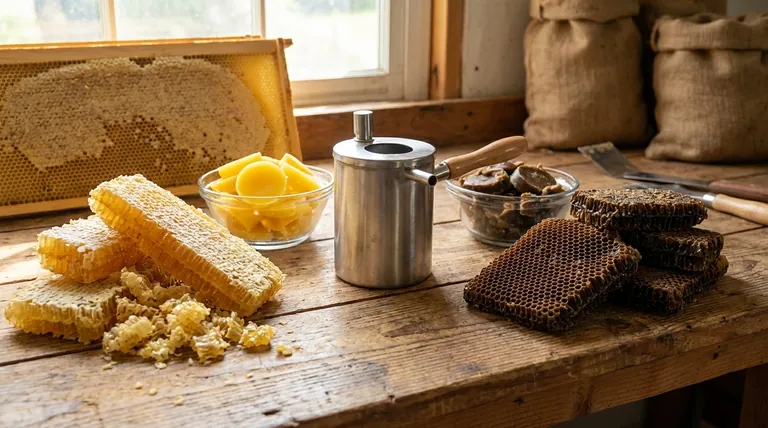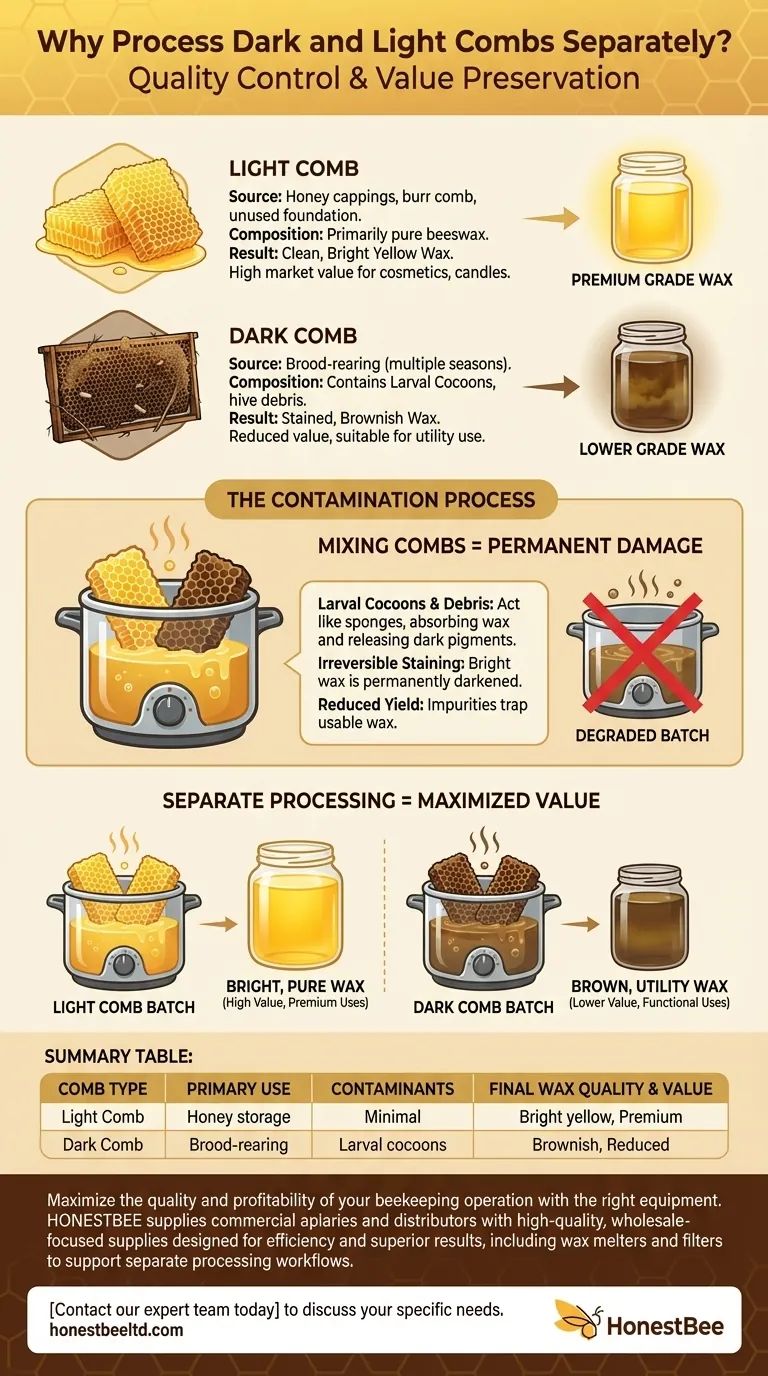The short answer is quality control. Processing dark and light combs separately is the single most important step for preventing contamination of your final beeswax. Dark combs contain impurities, primarily larval cocoons from the brood nest, which will stain your clean wax, permanently darken its color, and significantly reduce its market value.
Separating your combs before rendering isn't just about achieving a lighter color; it's a fundamental practice to maximize the purity, yield, and financial value of your beeswax. Mixing them irretrievably degrades your highest quality wax with contaminants from the lower quality comb.

The Anatomy of Bee Comb
To understand the need for separation, we must first recognize that not all comb is created equal. The comb's history and purpose within the hive directly determine its composition and quality for rendering.
What Defines a "Light" Comb?
A light comb is typically yellow or off-white and is primarily composed of pure beeswax. These are often honey cappings, burr comb, or new foundation that has not been used for raising brood.
Rendering light comb yields a clean, bright yellow beeswax that is highly sought after for cosmetics, candles, and other premium applications.
What Makes a "Dark" Comb?
A dark comb is one that has been used for brood-rearing, often for multiple seasons. Its color can range from tan to dark brown or nearly black.
The darkness is not from the wax itself but from materials left behind within the wax cells after bees have hatched.
The Source of Contamination: Larval Cocoons
The primary contaminant in dark comb is the larval cocoon. After a bee larva pupates, it spins a silken cocoon inside its cell. When the adult bee emerges, this thin cocoon is left behind.
With each generation of brood raised in a cell, another layer of cocoon is added. These accumulated layers, along with other hive debris, are what give old brood comb its dark, tough, and fibrous texture.
How Contamination Degrades Your Wax
The rendering process involves melting the wax to separate it from impurities. However, when dark combs are included, the impurities become part of the final product.
The Staining Process
During melting, the pure beeswax liquefies. The silken cocoons and other debris in the dark comb act like tiny sponges, absorbing some of the molten wax.
More importantly, these materials release accumulated pigments and impurities that permanently stain the liquid wax. This turns the entire batch from a desirable bright yellow to a much less valuable brownish color.
The Impact on Final Value
A small amount of dark comb can easily contaminate and darken a large batch of high-quality wax from light combs.
Buyers and crafters prize light, pure beeswax for its consistent quality and color. Darker, contaminated wax may require additional, costly filtering or be unsuitable for premium products, forcing you to sell it at a lower price.
Understanding the Trade-offs
It can be tempting to simply process all your wax-bearing material in a single batch to save time. This is a false economy.
The Hidden Cost of Reduced Yield
The absorbent larval cocoons do more than just stain the wax; they trap and retain a significant amount of it.
When you process dark combs, a portion of your beeswax remains locked within the slumgum (the leftover debris), reducing your overall yield of clean, usable wax.
The Damage is Irreversible
Once clean, yellow beeswax has been stained by the impurities from dark brood comb, the damage is done.
There is no simple, effective way to remove the dark pigments and restore the wax to its original bright quality. You have permanently downgraded your most valuable product.
Making the Right Choice for Your Goal
Your processing strategy should be dictated by the intended use of your beeswax and your desire to maximize its value.
- If your primary focus is creating high-grade wax for sale, cosmetics, or candles: Always render light combs and dark combs in completely separate batches. This protects the quality of your best wax.
- If your primary focus is utility and personal use (e.g., fire starters, waterproofing): Combining combs may be an acceptable shortcut, but understand you are sacrificing both the quality and potential yield of your wax.
By managing your comb processing with intention, you transform a simple byproduct of beekeeping into a high-value asset.
Summary Table:
| Comb Type | Primary Use in Hive | Key Contaminants | Final Wax Quality & Value |
|---|---|---|---|
| Light Comb | Honey storage, cappings | Minimal (pure beeswax) | Bright yellow, high-grade, premium value |
| Dark Comb | Brood-rearing (multiple seasons) | Larval cocoons, hive debris | Brownish, lower-grade, reduced value |
Maximize the quality and profitability of your beekeeping operation with the right equipment.
HONESTBEE supplies commercial apiaries and beekeeping equipment distributors with high-quality, wholesale-focused supplies designed for efficiency and superior results. Whether you need wax melters, filters, or foundation to support your separate processing workflow, we have the solutions to protect your product's value.
Contact our expert team today to discuss your specific needs and learn how our products can enhance your beeswax yield and purity.
Visual Guide

Related Products
- Professional Stainless Steel Wax Melter for Beekeeping and Crafts
- Beeswax Melter for Candle Making Honey Bee Wax Melter
- Steam Beeswax Melter Wax Warmer for Wax Processing
- Electric Beeswax Foundation Machine With Operating Tray and Wax Foundation Roller
- Electric Flatting and Embossing Machine with Tray for Beekeeping
People Also Ask
- How can you monitor the temperature of beeswax as it melts? Ensure Quality & Safety with Precise Control
- What are the safety precautions when working with melted beeswax? Prevent Burns and Fire Hazards
- Can I melt beeswax in a wax melter? The Key to Safe, High-Quality Results
- What is the flashpoint of beeswax? Essential Safety and Quality Tips for Beekeepers
- What are wax melters used for? Unlock Efficient Wax Processing for Your Business



















